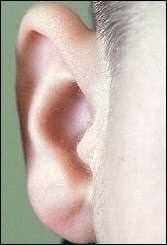Did our ancestors breathe through their ears?

A fossil fish skull from Latvia that researchers from Uppsala University, Sweden, describe in this weeks issue of Nature shows that the earliest land animals probably breathed through their ears.
"It looks as if the first step in the evolution of the middle ear had nothing to do with hearing. Our forebears developed ears in order to breathe through them," says Professor Per Ahlberg.
The human sense of hearing is based on the interaction of two different organs: the inner ear and the middle ear. The inner ear contains sensory cells that capture sound vibrations and send them on as nerve impulses to the brain. The middle ear is an ingenious mechanical audio amplifier that captures the weak sound vibrations in the air with a membrane (the eardrum), amplifies them with a leverage system (ear bones) and sends them on to the inner ear. Without the middle ear, the inner ear would not function.
All vertebrates have inner ears, but the middle ear exists only in land animals. Fish dont need middle ears since sound vibrations are stronger in water and easily pass through the body of a fish. The construction of the middle ear differs, however, among different groups of land animals: mammals have an eardrum and three ear bones (hammer (malleus), anvil (incus), and stirrup (stapes)), while birds, reptiles, and frogs have only one ear bone (stirrup) that connects the eardrum directly to the inner ear. But it is questionable whether the eardrums in mammals, reptiles, and frogs are identical or whether they arose independently of each other.
A comparison with fish muddies the picture even further: instead of middle ears, fish have a little gill, the blow-hole, that isnt covered by an eardrum but rather forms an open canal between the throat and the outside of the head. The equivalent of the stirrup, the hyomandibula, supports the gill lid but has no contact with the inner ear. Neither the hyomandibula nor the blow-hole plays any role in hearing.
These differences make it difficult to understand how the middle ear arose. How could evolution change both the structure and function of the fishes‚ blow-hole so radically? Did the earliest land animals have a sound amplifying middle ear at all? The earliest fossil land vertebrates or tetrapods, like Acanthostega from Greenland (that lived roughly 360 million years ago), had a stirrup that was in contact with the inner ear, but it was large and clumsy and appears not to have been connected to the eardrum. They also had a couple of round Œoutlets‚ in the rear edge of the skull: in modern frogs the corresponding outlet is the fastening point for the eardrum, but in fish it is the site of the outer opening of the blow-hole. This combination of characteristics has led to the hypothesis that the earliest land animals still had open blow-holes and perhaps breathed through them.
The Uppsala scientists‚ new data strongly support this hypothesis. The information comes from the skull of a Panderichthys from Latvia, the fossil fish that is closest to the emergence of land animals. It has been known that Panderichthys had a hyomandibula, and it was generally assumed that its blow-hole was of the normal fish type. But this is not the case: in actual fact the hole is similar to the middle ear‚ of a tetrapod like Acanthostega. Since the hyomandibula of the Panderichthys had no contact with the inner ear, its blow-hole could hardly have had a sound-amplification function.
"Thus the transformation of the form of the blow-hole must have been caused by another driving force than the improvement of hearing," says Per Ahlberg.
Compared with closely related fish, the blow-hole in Panderichthys has a considerably larger diameter and is furthermore both shorter and straighter. It looks like an adaptation to active breathing (of either water or air) through the blow-hole, compared with ordinary‚ fish in which only a small portion of breathing water passes through this hole. A similar adaptation can be seen in modern rays, which have a very large blow-hole.
Since the middle ear‚ in the earliest tetrapods has the same form as the blow-hole‚ in Panderichthys, it seems likely that they retained the breathing function. But in tetrapods the gill lid is gone and the hyomandibula is transformed into a primitive stirrup. The fact that the stirrup has contact with the inner ear indicates that a rudimentary hearing function had also been added.
"We can speculate about how this came about. The blow-hole of a fish can be closed by a valve muscle on top. If an early tetrapod did the same thing, a truly enclosed middle ear was temporarily created, where the stirrup, which probably supported the wall of the middle ear, could forward vibrations from the middle ear to the inner ear. When the hearing function eventually became more important, the blow-hole was permanently closed by an eardrum," reasons Per Ahlberg.
The article is being published in Nature on January 19.
Source: Uppsala Universitet















